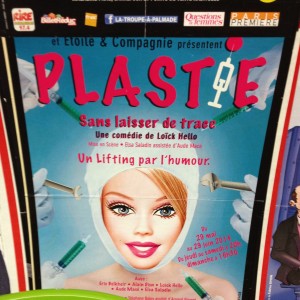
a play advertised in Paris
I love being a plastic surgeon, and I’m also aware that there are a lot of misconceptions about it. Also, it’s such a broad field that there are different kinds of plastic surgeons, who have sub-specialized.
The “Plastic” in plastic surgery does not refer to surgeons implanting plastic, or making people into plastic. The adjective for the specialty came from the Greek “plastikos,” from the word “plassein”, meaning to mold or reshape, and the term “plastic surgery” was first used in the 1800s, although reconstruction has been recorded as being performed as early as 2500 BC in Egypt.
So, the fundamentals of plastic surgery are about recreating or reshaping a form – from repairing a cleft lip, to reconstructing a breast after cancer, to refining the shape of a nose or chin. Plastic surgeons are trained to operate all over the body to repair what has been lost by trauma or cancer, treat congenital deformities, as well as sculpting areas to make them more aesthetic.
If you’ve seen Dr. 90210, or Botched, you are well acquainted with the cosmetic side of plastic surgery (as well as the potential complications). Also within plastic surgery, surgeons can subspecialize in craniofacial surgery like me, hand surgery, or microsurgery, which involves nerve reconstruction, or transferring tissue from healthy areas to areas requiring tissue coverage, by sewing vessels together a few millimeters in diameter, using suture finer than human hair.
Know that if you choose (or need) a plastic surgeon, you are seeing a specialist who has spent at least 6 years in surgical training with both deep and broad expertise. For me, it was tough, and fun, and worth every minute!
